Thermal Stress Analysis of Environmental Barrier Coatings Considering Interfacial Roughness
Abstract
:1. Introduction
2. Modeling Methodology
2.1. Coating System and Material Propperties
2.2. Model Geometry and Boundary Conditions
2.3. Simulation Procedure
- (1)
- Before the EBCs was deposited on the surface of CMCs at 1000 °C, all the constituents were assumed to be stress free;
- (2)
- After the preparation the coated system was cooled down to 0 °C, thermal residual stress is introduced;
- (3)
- At last, the coated system was analyzed under a typical operating condition. The top surface was heated by 1700 °C high-temperature gas; the convective heat transfer coefficient is 8000 W/(m2·°C). While the bottom surface of CMCs was cooled by 500 °C air, and the convective heat transfer coefficient is 8000 W/(m2·°C).
2.4. Numerical Implementation
3. Results and Discussions
3.1. The Effect of Rough Interface on Thermal Residual Stress
3.2. The Effect of Rough Interface On Thermal Stress under Service Conditions
3.3. Analysis of Possible Failure Mode
4. Conclusions
- During the processing, considerable thermal residual stress is induced in coatings. Large in-plane and through-thickness residual stress may cause vertical cracks in the EBC layer and delamination cracks at the interface between the EBC and BC layer. The rough interface plays an important role in the distribution of thermal residual stress. Stress concentration occurs near the peak and valley of the rough interface. The range of stress variation increases with the amplitude while decreases with the wavelength.
- Under the typical service conditions for SiC/SiC composites, the thermal residual stress in the T/EBC coating system can be eliminated to some extent. However, large thermal stress may be induced at the surface layer of TBC due to the thermal gradient. This stress tends to cause surface cracks. Thus, the surface roughness has a significant impact on the thermal stress distribution. The magnitude and range of thermal stress increase with the roughness level.
Author Contributions
Funding
Conflicts of Interest
References
- Xu, Y.; Ren, S.; Zhang, W.; Wu, Z.; Gong, W.; Li, H. Study of thermal buckling behavior of plain woven C/SiC composite plate using digital image correlation technique and finite element simulation. Thin Wall Struct. 2018, 131, 385–392. [Google Scholar] [CrossRef]
- Li, J.; Martin, E.; Leguillon, D.; Dupin, C. A finite fracture model for the analysis of multi-cracking in woven ceramic matrix composites. Compos. Part B Eng. 2018, 139, 75–83. [Google Scholar] [CrossRef] [Green Version]
- Dong, X.; Shin, Y.C. Predictions of thermal conductivity and degradation of irradiated SiC/SiC composites by materials-genome-based multiscale modeling. J. Nucl. Mater. 2018, 512, 268–275. [Google Scholar] [CrossRef]
- Fang, G.; Li, L.; Gao, X.; Song, Y. Finite Element Analysis of the Crack Deflection in Fiber Reinforced Ceramic Matrix Composites with Multilayer Interphase Using Virtual Crack Closure Technique. Appl. Compos. Mater. 2020, 27, 307–320. [Google Scholar]
- Song, Y.; Gao, X.; Sun, Z. Progress on Fatigue Hysteresis Mechanisms and Models of Aero-engine Ceramic Matrix Composites. J. Nanjing Univ. Aeronaut. Astronaut. 2019, 51, 417–426. [Google Scholar]
- Xu, J.; Sarin, V.K.; Dixit, S.; Basu, S.N. Stability of interfaces in hybrid EBC/TBC coatings for Si-based ceramics in corrosive environments. Int. J. Refract. Met. Hard Mater. 2015, 49, 339–349. [Google Scholar] [CrossRef]
- Lee, K.; Roode, M.; Kashyap, T. Environmental Barrier Coatings for Ceramic Matrix Composites-an Overview; GRC-E-DAA-TN38835; NASA: Washington, DC, USA, 2017.
- Białas, M. Finite element analysis of stress distribution in thermal barrier coatings. Surf. Coat. Technol. 2008, 202, 6002–6010. [Google Scholar] [CrossRef]
- Wang, L.; Wang, Y.; Sun, X.G.; He, J.Q.; Pan, Z.Y.; Wang, C.H. Finite element simulation of residual stress of double-ceramic-layer La2Zr2O7/8YSZ thermal barrier coatings using birth and death element technique. Comput. Mater. Sci. 2012, 53, 117–127. [Google Scholar] [CrossRef]
- Wang, L.; Wang, Y.; Zhang, W.Q.; Sun, X.G.; He, J.Q.; Pan, Z.Y.; Wang, C.H. Finite element simulation of stress distribution and development in 8YSZ and double-ceramic-layer La2Zr2O7/8YSZ thermal barrier coatings during thermal shock. Appl. Surf. Sci. 2012, 258, 3540–3551. [Google Scholar]
- Yu, Q.M.; Cen, L.; Wang, Y. Numerical study of residual stress and crack nucleation in thermal barrier coating system with plane model. Ceram. Int. 2018, 44, 5116–5123. [Google Scholar] [CrossRef]
- Bhattacharyya, A.; Maurice, D. Residual stresses in functionally graded thermal barrier coatings. Mech. Mater. 2019, 129, 50–56. [Google Scholar] [CrossRef]
- Nayebpashaee, N.; Seyedein, S.H.; Aboutalebi, M.R.; Sarpoolaky, H.; Hadavi, S.M.M. Finite element simulation of residual stress and failure mechanism in plasma sprayed thermal barrier coatings using actual microstructure as the representative volume. Surf. Coat. Technol. 2016, 291, 103–114. [Google Scholar] [CrossRef]
- Rezvani Rad, M.; Farrahi, G.H.; Azadi, M.; Ghodrati, M. Stress analysis of thermal barrier coating system subjected to out-of-phase thermo-mechanical loadings considering roughness and porosity effect. Surf. Coat. Technol. 2015, 262, 77–86. [Google Scholar] [CrossRef]
- Moridi, A.; Azadi, M.; Farrahi, G.H. Thermo-mechanical stress analysis of thermal barrier coating system considering thickness and roughness effects. Surf. Coat. Technol. 2014, 243, 91–99. [Google Scholar] [CrossRef]
- Al Nasiri, N.; Patra, N.; Pezoldt, M.; Colas, J.; Lee, W.E. Investigation of a single-layer EBC deposited on SiC/SiC CMCs: Processing and corrosion behaviour in high-temperature steam. J. Eur. Ceram. Soc. 2019, 39, 2703–2711. [Google Scholar] [CrossRef]
- Appleby, M.P.; Zhu, D.; Morscher, G.N. Mechanical properties and real-time damage evaluations of environmental barrier coated SiC/SiC CMCs subjected to tensile loading under thermal gradients. Surf. Coat. Technol. 2015, 284, 318–326. [Google Scholar] [CrossRef] [Green Version]
- Lee, K.N.; Eldridge, J.I.; Robinson, R.C. Residual Stresses and Their Effects on the Durability of Environmental Barrier Coatings for SiC Ceramics. J. Am. Ceram. Soc. 2005, 88, 3483–3488. [Google Scholar] [CrossRef]
- Zhang, X.; Zhou, K.; Liu, M.; Deng, C.; Niu, S.; Xu, S. Preparation of Si/Mullite/Yb2SiO5 Environment Barrier Coating (EBC) by Plasma Spray-Physical Vapor Deposition (PS-PVD). J. Inorg. Mater. 2018, 33, 325–330. [Google Scholar]
- Abdul-Aziz, A.; Bhatt, R.T. Modeling of thermal residual stress in environmental barrier coated fiber reinforced ceramic matrix composites. J. Compos. Mater. 2012, 46, 1211–1218. [Google Scholar] [CrossRef]
- Heveran, C.M.; Xu, J.; Sarin, V.K.; Basu, S.N. Simulation of stresses in TBC–EBC coating systems for ceramic components in gas turbines. Surf. Coat. Technol. 2013, 235, 354–360. [Google Scholar] [CrossRef]
- Song, Y.; Zhuan, X.; Wang, T.J.; Chen, X. Thermal Stress in Fabrication of Thermal Barrier Coatings. J. Therm. Stresses 2014, 37, 1390–1415. [Google Scholar] [CrossRef]
- Lee, K.N.; Fox, D.S.; Bansal, N.P. Rare earth silicate environmental barrier coatings for SiC/SiC composites and Si3N4 ceramics. J. Eur. Ceram. Soc. 2005, 25, 1705–1715. [Google Scholar] [CrossRef]
- Robertson, A.L.; Solá, F.; Zhu, D.; Salem, J.; White, K.W. Microscale fracture mechanisms of HfO2-Si environmental barrier coatings. J. Eur. Ceram. Soc. 2019, 39, 2409–2418. [Google Scholar] [CrossRef]
- Shen, X.; Qiao, Y.; Dong, S.; Liu, X.; Gong, L. Thermal Load Test Method and Numerical Calculation for Ceramic Matrix Composite Turbine Guide Vane. Appl. Compos. Mater. 2019, 26, 553–573. [Google Scholar] [CrossRef]
- Eriksson, R.; Sjöström, S.; Brodin, H.; Johansson, S.; Östergren, L.; Li, X.-H. TBC bond coat–top coat interface roughness: Influence on fatigue life and modelling aspects. Surf. Coat. Technol. 2013, 236, 230–238. [Google Scholar] [CrossRef] [Green Version]
- Gadelmawla, E.S.; Koura, M.M.; Maksoud, T.M.A.; Elewa, I.M.; Soliman, H.H. Roughness parameters. J. Mater. Process. Technol. 2002, 123, 133–145. [Google Scholar] [CrossRef]
- Zhu, D.; Nemeth, N.N. Environmental Barrier Coating Fracture, Fatigue and High-Heat-Flux Durability Modeling and Stochastic Progressive Damage Simulation; GRC-E-DAA-TN48415; NASA: Washington, DC, USA, 2017.
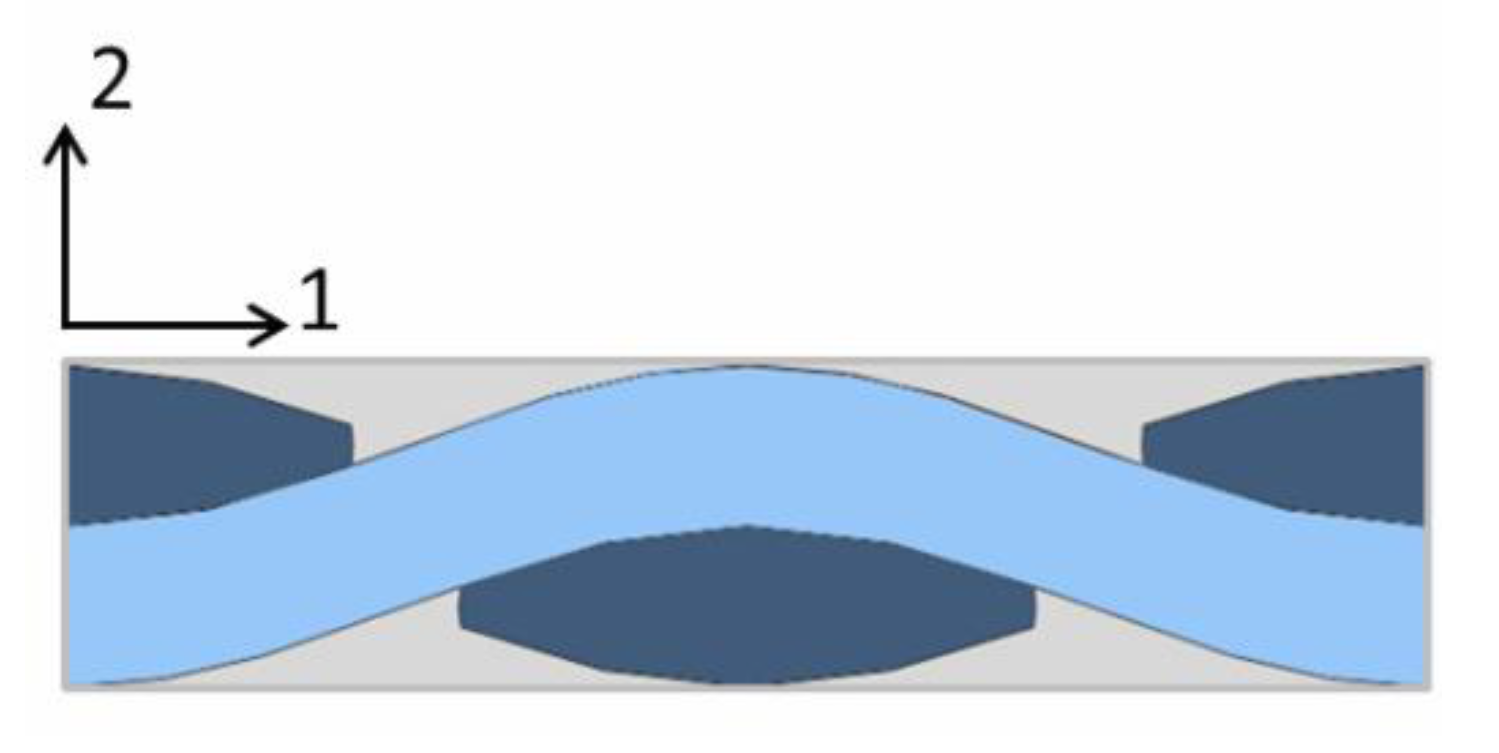

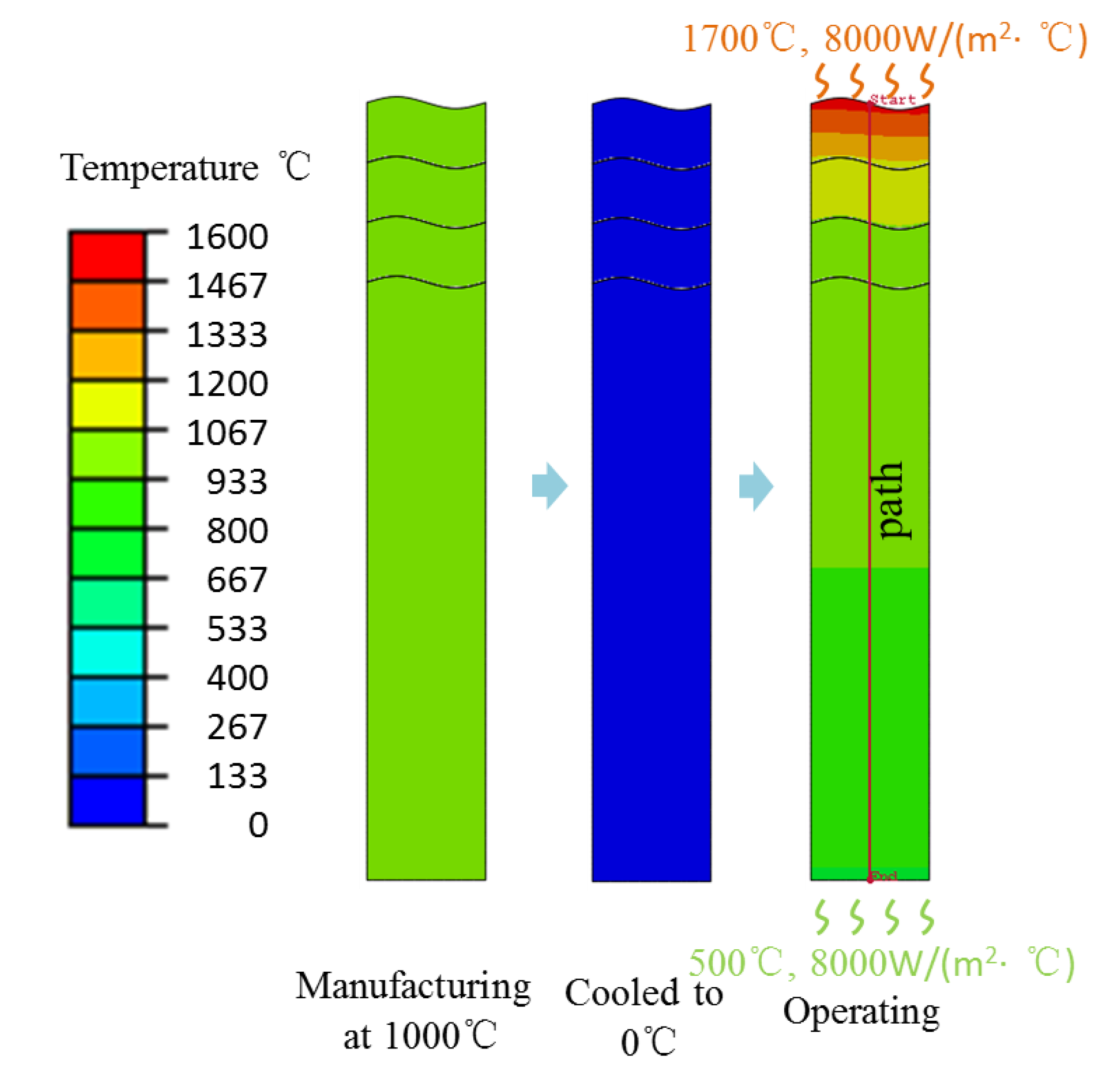
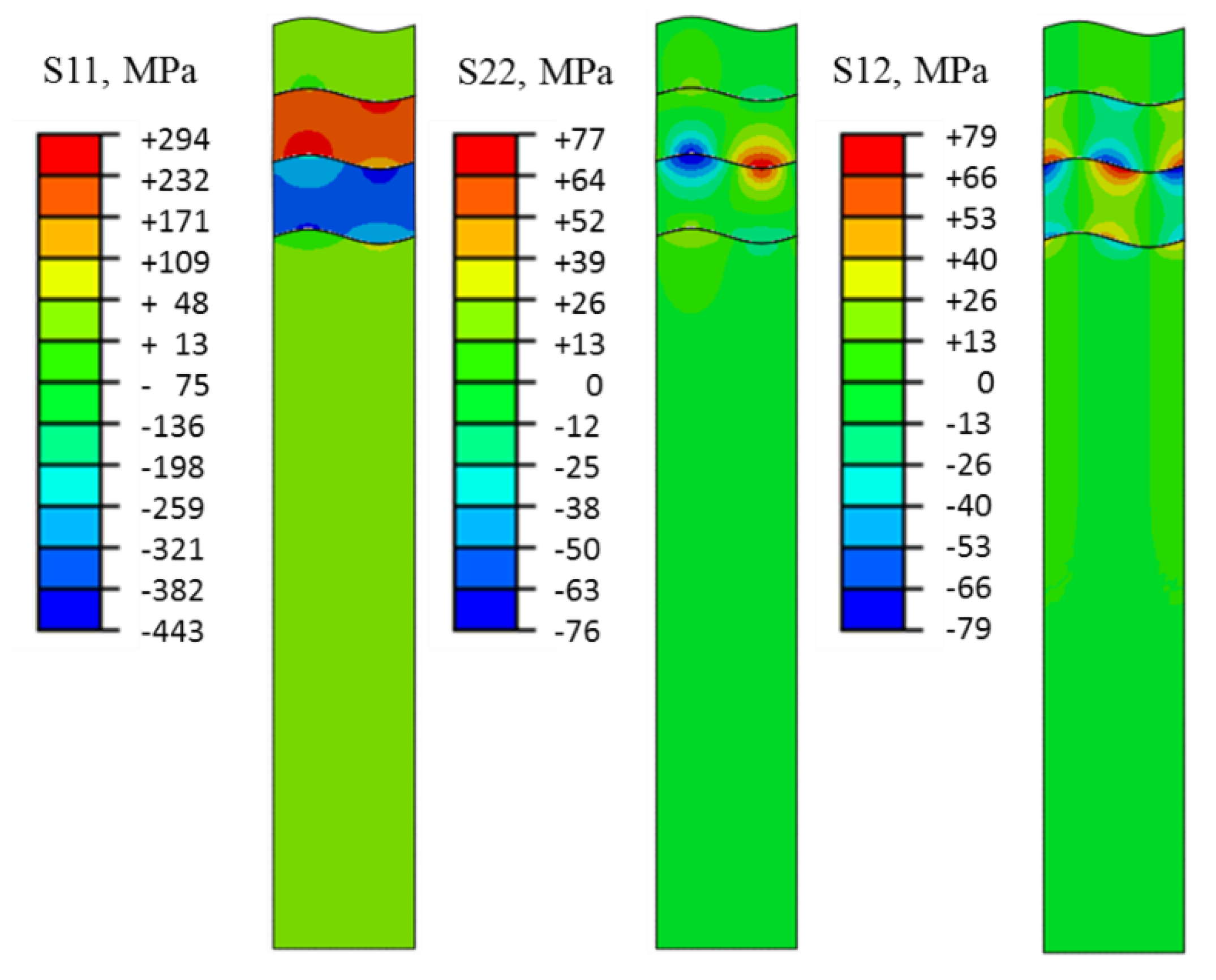


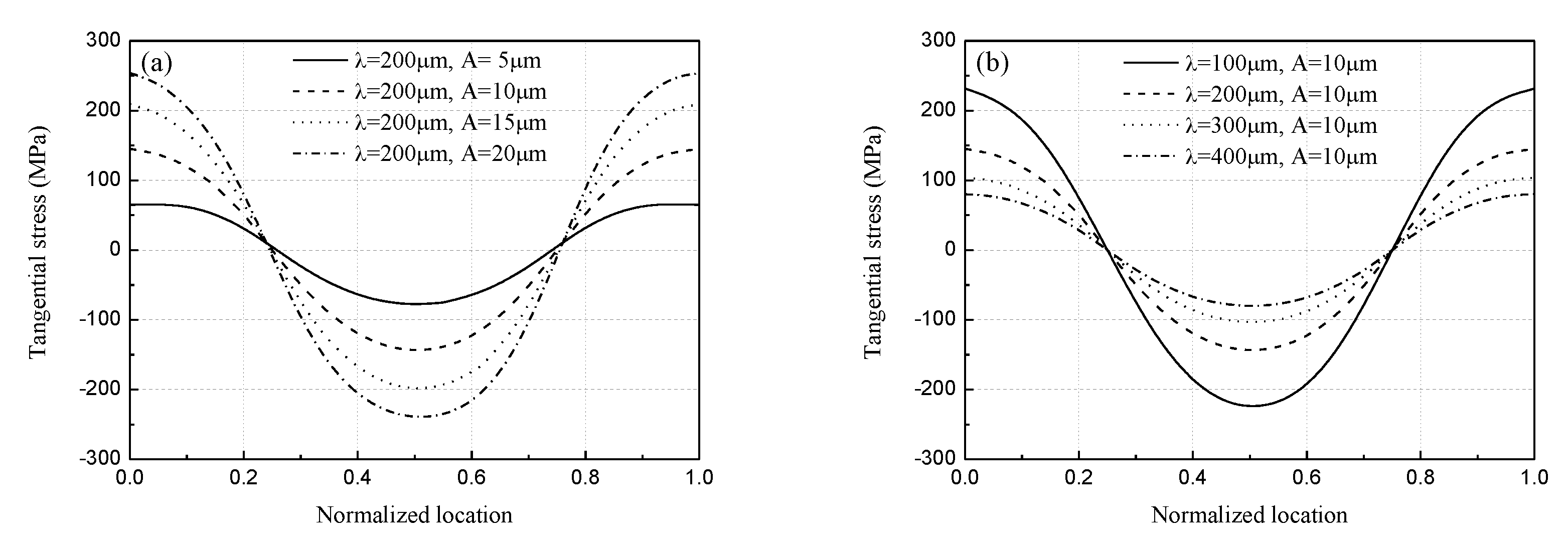
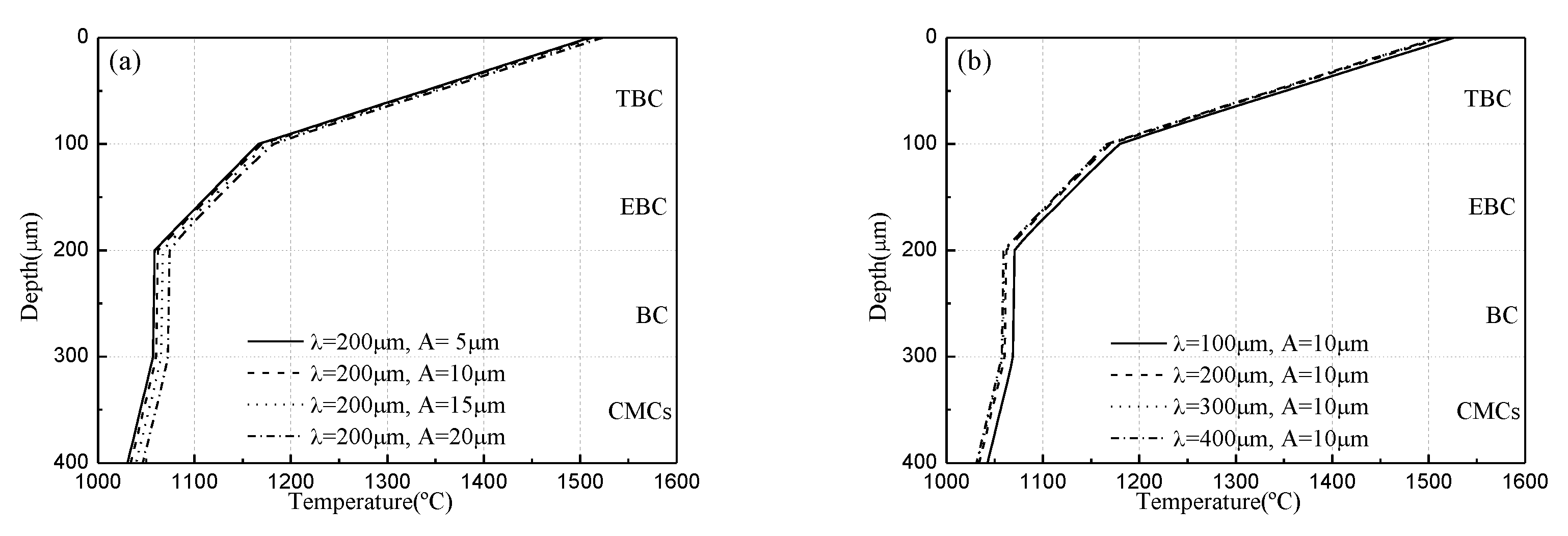


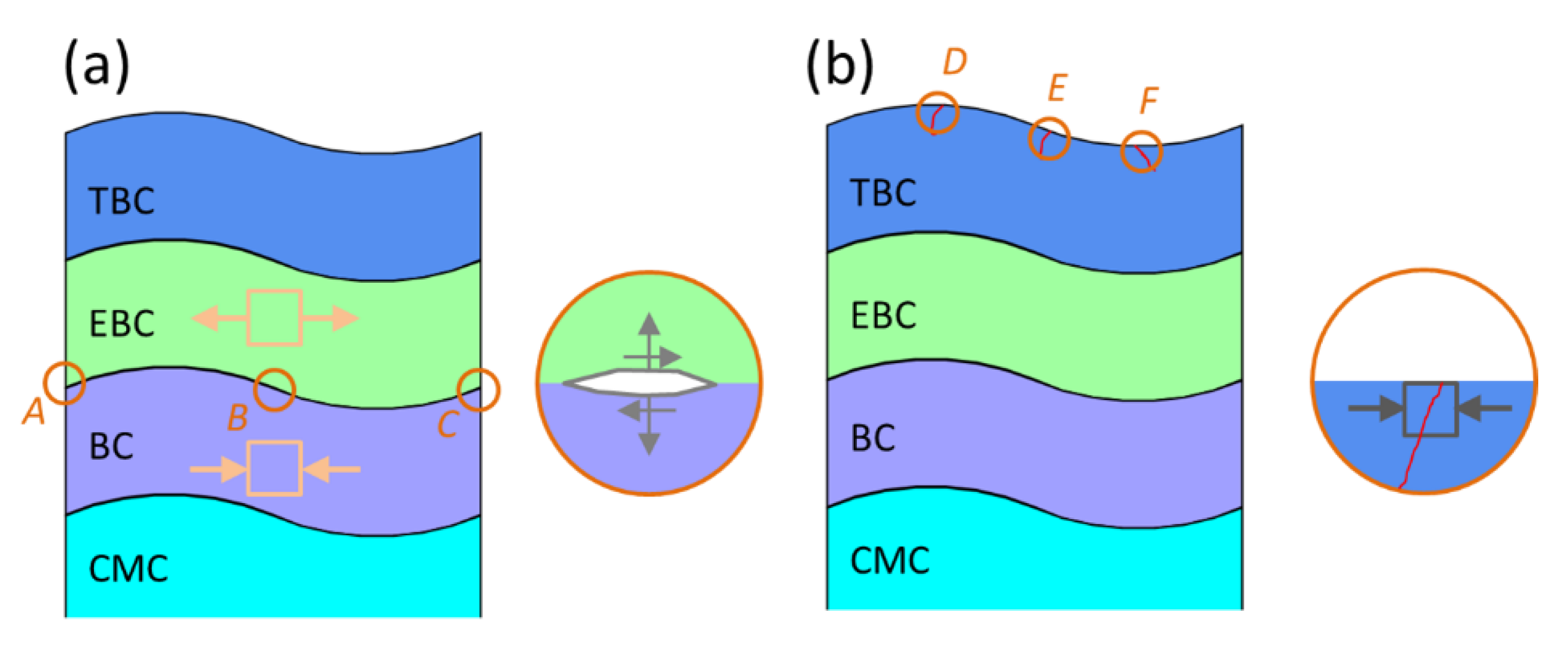
| Constituents | E/GPa | v | k/(W·m−1·K−1) | α/(×10−6K−1) |
|---|---|---|---|---|
| TBC (La2Zr2O7) | 63 | 0.25 | 0.87 | 4.25 |
| EBC (Yb2Si2O7) | 150 | 0.28 | 3.5 | 5.5 |
| BC (Si) | 97 | 0.21 | 14.23 | 3.5 |
| E1/GPa | E2/GPa | v12 | G12/GPa | k1/(W·m−1·K−1) | k2/(W·m−1·K−1) | α1/(×10−6K−1) | α2/(×10−6K−1) |
|---|---|---|---|---|---|---|---|
| 238.37 | 81.40 | 0.20 | 96.92 | 12.1 | 8.83 | 4.36 | 3.80 |
© 2020 by the authors. Licensee MDPI, Basel, Switzerland. This article is an open access article distributed under the terms and conditions of the Creative Commons Attribution (CC BY) license (http://creativecommons.org/licenses/by/4.0/).
Share and Cite
Fang, G.; Ren, J.; Shi, J.; Gao, X.; Song, Y. Thermal Stress Analysis of Environmental Barrier Coatings Considering Interfacial Roughness. Coatings 2020, 10, 947. https://doi.org/10.3390/coatings10100947
Fang G, Ren J, Shi J, Gao X, Song Y. Thermal Stress Analysis of Environmental Barrier Coatings Considering Interfacial Roughness. Coatings. 2020; 10(10):947. https://doi.org/10.3390/coatings10100947
Chicago/Turabian StyleFang, Guangwu, Jiacheng Ren, Jian Shi, Xiguang Gao, and Yingdong Song. 2020. "Thermal Stress Analysis of Environmental Barrier Coatings Considering Interfacial Roughness" Coatings 10, no. 10: 947. https://doi.org/10.3390/coatings10100947
APA StyleFang, G., Ren, J., Shi, J., Gao, X., & Song, Y. (2020). Thermal Stress Analysis of Environmental Barrier Coatings Considering Interfacial Roughness. Coatings, 10(10), 947. https://doi.org/10.3390/coatings10100947







